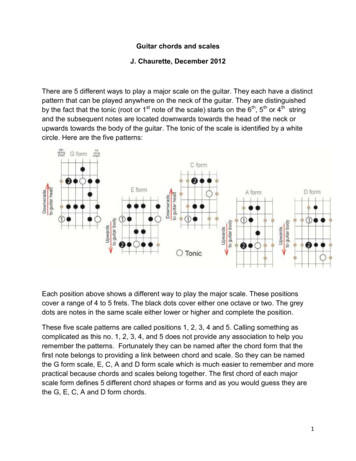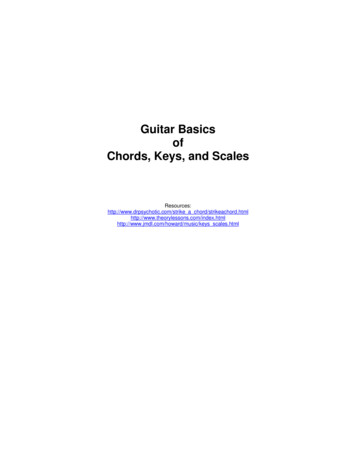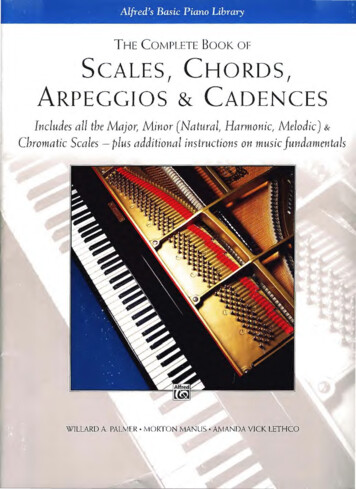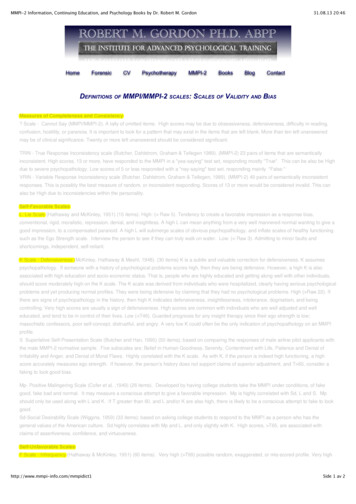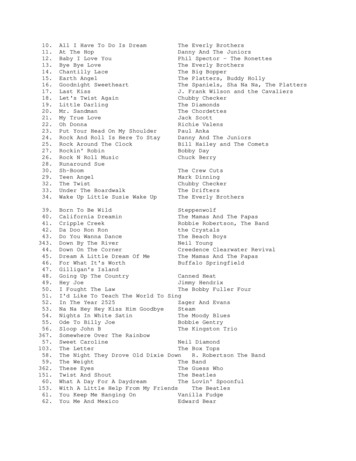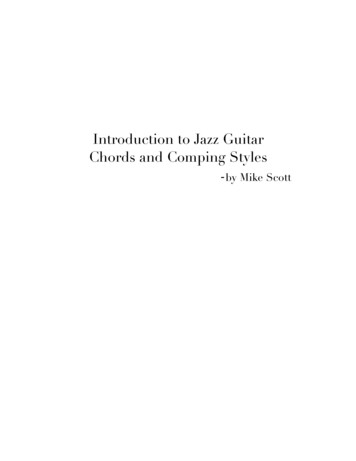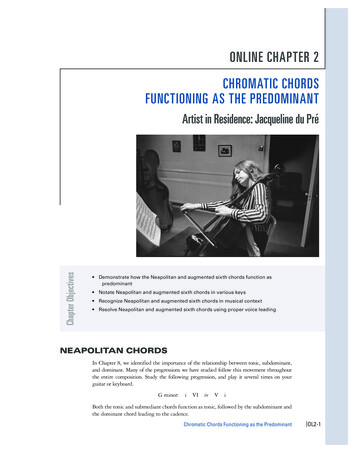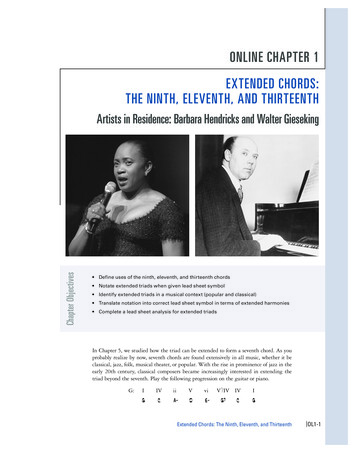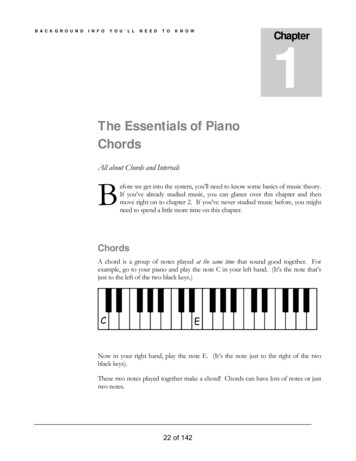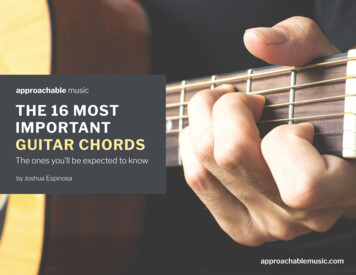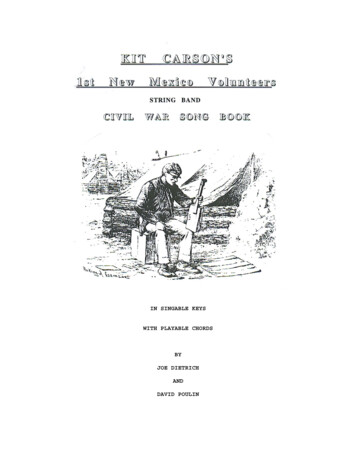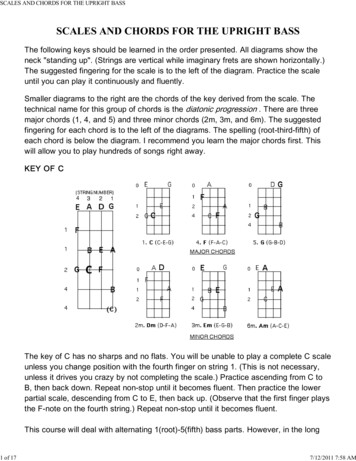
Transcription
SCALES AND CHORDS FOR THE UPRIGHT BASS1 of 17SCALES AND CHORDS FOR THE UPRIGHT BASSThe following keys should be learned in the order presented. All diagrams show theneck "standing up". (Strings are vertical while imaginary frets are shown horizontally.)The suggested fingering for the scale is to the left of the diagram. Practice the scaleuntil you can play it continuously and fluently.Smaller diagrams to the right are the chords of the key derived from the scale. Thetechnical name for this group of chords is the diatonic progression . There are threemajor chords (1, 4, and 5) and three minor chords (2m, 3m, and 6m). The suggestedfingering for each chord is to the left of the diagrams. The spelling (root-third-fifth) ofeach chord is below the diagram. I recommend you learn the major chords first. Thiswill allow you to play hundreds of songs right away.KEY OF CThe key of C has no sharps and no flats. You will be unable to play a complete C scaleunless you change position with the fourth finger on string 1. (This is not necessary,unless it drives you crazy by not completing the scale.) Practice ascending from C toB, then back down. Repeat non-stop until it becomes fluent. Then practice the lowerpartial scale, descending from C to E, then back up. (Observe that the first finger playsthe F-note on the fourth string.) Repeat non-stop until it becomes fluent.This course will deal with alternating 1(root)-5(fifth) bass parts. However, in the long7/12/2011 7:58 AM
SCALES AND CHORDS FOR THE UPRIGHT BASS2 of 17run it is a good idea to learn the complete chord arpeggio (all 1-3-5's) for variety. Learnthe major chords first, then the minor chords.The number of possible 1-5 bass parts depends upon how many roots and fifths areavailable in each chord. The C and Dm chords each have one root and two fifthsavailable allowing you to play two possible 1-5 bass parts. The F and G chords eachhave two roots and one fifth available. This also will allow you to play two possible 1-5bass parts. The Em and Am chords have two roots and two fifths available allowingyou to play three possible bass parts. The following is a summary in the key of C.COUNTING MEASURESMost songs have four beats to a measure and most songs are made up offour-measure pieces. Practice counting four-measure pieces as follows (recite out louduntil fluent):When the counting is to the point of a "no-brainer" then play a root-fifth C-chord. Whilecontinuing to count play the root on the first beat and the fifth on the third beat. Thismethod of counting and playing a single chord must become a "no-brainer" before youadvance to the next phase.The bass player is the heart of the band. A steady bass player can keep other playersin line so practice with a metronome to develop steady timing. (Tapping your foot onbeats one and three is also a good idea.)Here's the next phase!Progression 1:1 Practice the following 16-measure progression continuously whilecounting and changing chords every four measures. (Always play a root on the first7/12/2011 7:58 AM
SCALES AND CHORDS FOR THE UPRIGHT BASS3 of 17beat and a fifth on the third beat.) Memorize and work out variations.Progression 2:2 Practice the following 8-measure progression while counting andchanging chords every two measures. Memorize and work out variations.Progression 3:3 Practice the following 4-measure progression while counting andchanging chords every measure. Memorize and work out variations.TWO-CHORD SONGSThe following simple songs can be played using just the 1- and 5-chords. Play a rooton the first beat of the measure and a fifth on the third beat. Memorize eachprogression and use variations.This 8-measure progression is good for all of the following songs: MARY HAD ALITTLE LAMB, LONDON BRIDGE, BUFFALO GALS, GO TELL AUNT RHODY, LONGLONG AGO.SKIP TO MY LOU and HE'S GOT THE WHOLE WORLD uses this chord progression.7/12/2011 7:58 AM
SCALES AND CHORDS FOR THE UPRIGHT BASS4 of 17The following progression is good for ACHY BREAKY HEART, TOM DOOLEY, POLLYWOLLY DOODLE, and TAKE ME BACK TO TULSA. (This progression is called a"reversal", the second half is the opposite of the first.)The following songs are reversals.The following 4-measure progression is SHORTNIN' BREAD and FARMER IN THEDELL. Observe that measure 4 is split in half--two beats on the 5-chord, two beats onthe 1-chord. When this happens play the root of each chord. (From now on smallletters will indicate the bass line only during measures where there may be confusion)A song with several "split-measures" is SHOO FLY.THREE-CHORD SONGSHundreds of songs can be played using the 1-, 4- and 5-chords. Examples are:7/12/2011 7:58 AM
SCALES AND CHORDS FOR THE UPRIGHT BASS5 of 17The following are variations of the 12-bar (12-measure) blues, a common progressionfor many early rock and roll songs. (The last 5-chord in progression 1 is optional.)Popular 12-bar blues songs are BLUES STAY AWAY (progression 1), HOUND DOG(2), JOHNNY B. GOODE (1), KANSAS CITY (3), MIND YOUR OWN BUSINESS (2),ROCK AROUND THE CLOCK (1), ROLL OVER BEETHOVEN (2 & 3)COUNTING 3-BEAT MEASURESA song with three beats per measure is called a waltz . A waltz has a distinctboom-chuck-chuck rhythm with a heavy accent on the first beat. Practice countingfour-measure pieces as follows (recite it out loud):After the counting becomes effortless play a C-chord, alternating between the root andfifth on the first beat of each measure. This method of counting and playing a singlechord must become a no-brainer before you advance to the next phase.And here's the next phase . . .Progression 1:1 Practice this 16-measure progression continuously while counting andchanging chords every four measures.7/12/2011 7:58 AM
SCALES AND CHORDS FOR THE UPRIGHT BASS6 of 17Progression 2:2 Practice this 8-measure progression while counting and changingchords every two measures.Progression 3:3 When the chord changes after one measure play only the root.Practice this 4-measure progression while counting and changing chords everymeasure.Here are some familiar songs in 3/4 time.Measure seven of HAPPY BIRTHDAY contains two chords. Sustain the 1-chord fortwo beats (the "slash" indicates another beat of 1) and play the 5-chord on the thirdbeat.DIATONIC SONGS7/12/2011 7:58 AM
SCALES AND CHORDS FOR THE UPRIGHT BASS7 of 17A song written using only chords from the standard chord formula derived from a majorscale (1, 2m, 3m, 4, 5, 6m, 7 or 57) is said to be diatonic . If a song uses only thethree major chords in a key (1, 4, & 5) the changes are fairly easy to hear andanticipate. (At the very least you have a 50% chance of changing to the right chordfrom wherever you are!) Songs become more complicated when minor chords (2m, 3m,& 6m) are introduced. It is simple to tell the difference between a major and minorchord when played out of context (major chords are "happy", minor chords are "sad".)However, in the context of a key it is sometimes difficult to tell them apart. This is notnegative, rather minor chords add variety to songs. With experience you will soon learnto play and discern all of the chord changes within a key.The following 4-measure progressions utilize minor chords in typical fashion.If you learn to hear the changes in this progression you will be able to interprethundreds of songs on your own.Process of Elimination and Frequency of UseWhen you are interpreting (by ear) chord changes involving minor chords use thefollowing procedure. Try the 6m chord first as it is used far more often than the otherminor chords. If that doesn't fly try the 2m which is used the second most often. Ifneither the 6m or 2m work try the 3m, the least-used minor chord. If none of them workthe song may be using an accidental chord, one that is outside of the key.KEY OF G7/12/2011 7:58 AM
SCALES AND CHORDS FOR THE UPRIGHT BASS8 of 17The key of G has one sharp (F#). Play a complete scale ascending from the low G onstring 4 to the high G on string 1 then back down. Repeat non-stop until it becomesfluent. (When playing all notes in the position observe that strings 4 & 3 are fingeredthe same as are strings 2 & 1.)NOTE: Strings 4-3-2 of the G scale form the SAME FINGERING PATTERN as strings3-2-1 of the C scale. (The G scale is the C scale transposed from string 3 to string 4.)The key of G has four chords in common with the key of C (G, C, Em, and Am). Thetwo new chords are D and Bm. As long as you are only playing 1-5 bass parts theD-chord will be the same as the Dm. However, the Bm-chord will be totally new. Belowis a summary of chords and possible 1-5 bass lines in the key of G.(Play all the previous progressions in the key of G.)KEY OF DThe key of D has two sharps (F# & C#). You cannot complete a D scale in thisposition. Descending from D will allow you to play all the notes but a low D whileascending from D will allow you to play all notes but C# and high D. (When playing all7/12/2011 7:58 AM
SCALES AND CHORDS FOR THE UPRIGHT BASS9 of 17notes in the position observe that strings 3, 2, and 1 are fingered the same.)NOTE: Strings 4-3-2 of the D scale form the SAME FINGERING PATTERN as strings3-2-1 of the G scale. (The D scale is the G scale transposed from string 1 to string 2.)The key of D has four chords in common with the key of G (D, G, Bm, and Em). Thetwo new chords are A and F#m. As long as you are only playing 1-5 bass parts theA-chord will be the same as the Am. The F#m-chord will be totally new. Below is asummary of chords and possible 1-5 bass lines in the key of D.(Play all the previous progressions in the key of D.)KEY OF AThe key of A has three sharps (F#, C#, & G#). You can play a complete scale in thisposition. Use the first finger to play both the G# and the A on the first string. (Whenplaying all notes in the position observe that strings 4, 3, and 2 are fingered the same.)NOTE: Strings 4-3-2 of the A scale form the SAME FINGERING PATTERN as strings3-2-1 of the D scale. (The A scale is the D scale transposed from string 2 to string 3.)7/12/2011 7:58 AM
SCALES AND CHORDS FOR THE UPRIGHT BASS10 of 17The key of A has four chords in common with the key of D (A, D, F#m, and Bm). Thetwo new chords are E and C#m. As long as you are only playing 1-5 bass parts theE-chord will be the same as Em. The C#m-chord is new. Below is a summary of chordsand possible 1-5 bass lines in the key of A.(Play all the previous progressions in the key of A.)KEY OF EThe key of E has four sharps (F#, C#, G#, & D#). You can play a complete scale inthis position. The fingering for the E major scale is identical to that of an A scale exceptthat it will start upon string 4 instead of string 3. Use the first finger to play both D# andE on the second string. (When playing all notes in the position observe that strings 4 &3 are fingered the same as are strings 2 & 1.)NOTE: Strings 4-3-2 of the E scale form the SAME FINGERING PATTERN as strings3-2-1 of the A scale. (The E scale is the A scale transposed from string 3 to string 4.)7/12/2011 7:58 AM
SCALES AND CHORDS FOR THE UPRIGHT BASS11 of 17The key of E has four chords in common with the key of A (E, A, C#m, and F#m). Thetwo new chords are B and G#m. (As long as you are only playing 1-5 bass parts theB-chord will be the same as Bm.)(Play all the previous progressions in the key of E.)The Key of BBy now you should know how to practice a key. (Learn the scale and the new chordsthen play the progressions.) For the next two keys I will only show the scale patternand name the chords in the diatonic progression.The key of B has five sharps (F#, C#, G#, D#, and A#). You can play a complete scalein first position. The key of B has four chords in common with the key of E (B, E, G#m,and C#m). The two new chords are F# (F#-A#-C#) and D#m (D#-F#-A#).NOTE: Strings 4-3-2 of the B scale form the SAME FINGERING PATTERN as strings3-2-1 of the E scale. (The B scale is the E scale transposed from string 2 to string 3.)7/12/2011 7:58 AM
SCALES AND CHORDS FOR THE UPRIGHT BASS12 of 17The Key of F#The key of F# has six sharps (F#, C#, G#, D#, A#, and E#). The complete F# scale willbe fingered the same as the B scale except that it starts upon the fourth string. Thekey of F# has four chords in common with the key of B (F#, B, D#m, and G#m). Thetwo new chords are C# (C#-E#-G#) and A#m (A#-C#-E#).NOTE: Strings 4-3-2 of the F# scale form the SAME FINGERING PATTERN as strings3-2-1 of the B scale. (The F# scale is the B scale transposed from string 3 to string 4.)THE CIRCLE OF FIFTHSKeys should be learned in the order that they appear on the circle of fifths , thesystematical arrangement of the twelve keys. When approached in this order thefingering for the scale and chords are transposed to neighboring strings. (This"scrolling" effect is an important consideration when learning scales and arpeggios ona stringed instrument.)A major scale is constructed upon each of the twelve notes, creating twelve keys.Each key is identical in structure yet each is unique in the number of sharps or flats itcontains.Starting at the key of C and moving clockwise by intervals of fifths, a sharp is added to7/12/2011 7:58 AM
SCALES AND CHORDS FOR THE UPRIGHT BASS13 of 17each successive key until all seven notes are sharp (key of C#). The new sharp ineach key is the seventh note of that particular scale. Once a note is sharp it continuesto be sharp in the remaining sharp-keys. (New sharps are indicated with small lettersinside the circle.)Starting at the key of C and moving counterclockwise by intervals of fourths, a flat isadded to each successive key until all seven notes are flat (key of Cb). The new flat ineach key is the fourth note of that particular scale. Once a note is flat it continues to beflat in the remaining flat-keys. (New flats are indicated with small letters inside thecircle.)An overlapping of enharmonic (equivalent) keys occurs at three points on the circle offifths (the keys of C#/Db, F#/Gb, and B /Cb).It is not important to
letters will indicate the bass line only during measures where there may be confusion) A song with several "split-measures" is SHOO FLY. THREE-CHORD SONGS Hundreds of songs can be played using the 1-, 4- and 5-chords. Examples are: SCALES AND CHORDS FOR THE UPRIGHT BASS 4 of 17 7/12/2011 7:58 AM . The following are variations of the 12-bar (12-measure) blues, a common
